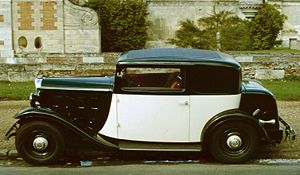
Citroën Rosalie
Encyclopedia

Citroën
Citroën is a major French automobile manufacturer, part of the PSA Peugeot Citroën group.Founded in 1919 by French industrialist André-Gustave Citroën , Citroën was the first mass-production car company outside the USA and pioneered the modern concept of creating a sales and services network that...
model range between 1932 and 1938. The three models were designated respectively the 8CV, the 10CV and the 15CV, the numbers defining the cars' fiscal horsepower
Tax horsepower
The tax horsepower or taxable horsepower was an early system by which taxation rates for automobiles were reckoned in some European countries, such as Britain, Belgium, Germany, France, and Italy; some US states like Illinois charged license plate purchase and renewal fees for passenger...
which in turn defined the approximate engine size of each model.
Chronology
At introduction, the larger Rosalies replaced the Citroëns C4 and C6, themselves launched respectively in 1928 and 1929. They also represented a move upmarket for the entire business, since during the early 1930s Citroën appeared for a time to lose interest in the smaller cars which had filled their dealerships during the impoverished 1920s. The Rosalies, especially the larger 15CV versions, were offered with range of different body types: this was normal practice at the time. Though not radical in terms of subsequent Citroën launches, the look of the Rosalies was significantly more modern than that of the earlier C4 and C6 models. However, the real revolution at Citroën during these years involved production technology. André CitroënAndré Citroën
André-Gustave Citroën was a French industrialist. He is remembered chiefly for the make of car named after him, but also for his application of double helical gears.- Life and career :...
had drawn practical inspiration from his 1912 visit to Henry Ford's
Henry Ford
Henry Ford was an American industrialist, the founder of the Ford Motor Company, and sponsor of the development of the assembly line technique of mass production. His introduction of the Model T automobile revolutionized transportation and American industry...
then new Highland Park Ford Plant
Highland Park Ford Plant
The Highland Park Ford Plant is a former factory located in Highland Park, Michigan at 91 Manchester Avenue . The second production facility for the Model T automobile, it became a National Historic Landmark in 1978.-Description:...
in Michigan
Highland Park, Michigan
- Geography :According to the United States Census Bureau, the city has a total area of , all land.- Demographics :As of the census of 2000, there were 16,746 people, 6,199 households, and 3,521 families residing in the city. The population density was 5,622.9 per square mile . There were 7,249...
, and in 1932 Citroën was still a European leader in the application of assembly line
Assembly line
An assembly line is a manufacturing process in which parts are added to a product in a sequential manner using optimally planned logistics to create a finished product much faster than with handcrafting-type methods...
manufacturing. Rosalies were competitively but apparently profitably priced.
In 1934 all the Rosalies received a facelift which involved applying a gently raked angle to the front grill. The post facelift versions that appeared were known as the NH versions. NH stood for "Nouvelle Habillage" (literally "New Clothing").
1934 was also the year that saw the introduction of the Rosalie's mould-shattering successor, the front wheel drive chassisless Citroën Traction Avant
Citroën Traction Avant
The Citroën Traction Avant is an automobile which was produced by the French manufacturer Citroën from 1934 to 1957. About 760,000 units were produced.-Impact on the world:...
. The Traction endured a troubled and prolonged birth process, however, and was part of an ambitious investment programme which involved, also in 1934, the bankruptcy of the business, and its acquisition by Citroën's principal creditor
Michelin
Michelin is a tyre manufacturer based in Clermont-Ferrand in the Auvergne région of France. It is one of the two largest tyre manufacturers in the world along with Bridgestone. In addition to the Michelin brand, it also owns the BFGoodrich, Kleber, Riken, Kormoran and Uniroyal tyre brands...
. The patron
André Citroën
André-Gustave Citroën was a French industrialist. He is remembered chiefly for the make of car named after him, but also for his application of double helical gears.- Life and career :...
himself died in 1935. In this troubled situation, availability of the larger Rosalies continued till 1938: it is only through the distorting prism of subsequent events that its reputation has been diminished when set against the technical brilliance of its successor.

